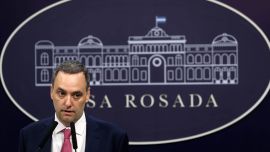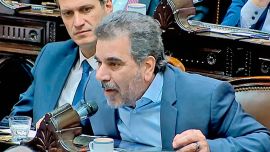Yesterday was Saint Patrick’s Day, as an increasingly globalised March 17 always has been and always will be, but ever since 1992 the exuberant carousals have had to co-exist with an appalling tragedy in Argentina at least – the terrorist car-bomb destruction of the Israeli Embassy.
The shock of that horrific event remains unique beyond the numbers. More people had died before (the 71 football fans crushed at River Plate stadium in 1968 or the 39 killed in the La Tablada military uprising in 1989, quite apart from the slaughter of thousands in more measured doses throughout the 1970s) and more people have died since, not least the 85 perishing in the next anti-Semitic bomb blast at the AMIA Jewish community centre 28 months afterwards with both terrorist outrages quantitatively eclipsed by the 194 young lives consumed in the Cromañon rock club blaze in late 2004, but that first jolt of stunned disbelief can never be repeated. Unlike the above tragedies, the death toll remains unclear today with the numbers of 22 and 29 both given by official sources – there were so many bits of bodies from the blast that assembling the body bags became a mission impossible with the final figure disputed to this day.
As it happened, these two sides of March 17 directly overlapped that day. The blasted Israeli Embassy on Arroyo and Suipacha was then flanked by the Irish and Romanian Embassies with the former closed for Saint Patrick’s Day. An Irish diplomat was bussing to a community event in Rosario and just two minutes into his journey, while still pulling out of Retiro terminal, he suddenly saw a huge mushroom cloud rising above the area he knew so well. “Oh my God, that’s my embassy! How could the IRA have reached Buenos Aires?” he thought. With no mobile telephones in those days he was stuck with that worry throughout the journey to Rosario before learning the news.
The shock was all the greater for its context towards the end of perhaps the calmest summer in a quarter of a century. Neither the bloodbaths of the 1970s followed by the 1982 South Atlantic war nor the 1983-1989 Raúl Alfonsín presidency ending in hyperinflation with its 1985 juntas trial (the subject of the film denied an Oscar last Sunday) and carapintada Army mutinies persisting through to 1990 could be called uneventful. But the convertibility introduced on April Fool’s Day, 1991, was finally clicking after a slow start, ending two years of four-digit annual inflation and giving Carlos Menem a comfortable midterm victory the previous spring. Life in Argentina was becoming almost boring – so much so that the foreign correspondents were starting to abandon an expensive city bereft of any interesting news.
A hard-won mood of complacency so rudely shattered. Nobody could understand what had hit them. A half-baked theory was widely circulated (persisting until today) whereby the atrocity was an Iranian reprisal for Menem contributing a couple of tiny corvettes to the 1990-1991 Gulf War fleet. Every reason to suspect the Islamic Republic of Iran, of course, but this motive made absolutely no sense – Saddam Hussein had slain almost a million Iranians in the then recent 1980-1988 Iran-Iraq war so why on earth should Tehran be angry with Menem for joining the international alliance to take Saddam out (unless they thought he should have contributed more)? The almost universal credence given to this interpretation shows vast ignorance of the Middle East.
As it happened, I perhaps had more reasons to suspect Iran than most without then realising it. In 1991 the Buenos Aires Herald newspaper (of which I was then co-Editor) embarked on a marketing strategy of covering the national days of every country with a Buenos Aires embassy in the form of interviewing their diplomatic representatives, while plugging related companies and chambers of commerce for ads – there was to be blanket coverage of all nations in the first two years before shortlisting the most worthwhile. Since Islamic Revolution Day falls in February, that month in 1992 found me dropping into the Iranian Embassy on Figueroa Alcorta for the corresponding interview (the notorious Mohsen Rabbani, posted at the Embassy for almost 15 years, was among my interlocutors). I was made to wait a good half hour in the entrance lobby before being admitted for my interview and during that period there was an almost incessant entry of huge crates accompanied by a lot of nattering in Farsi. “The biggest diplomatic pouch I’ve ever seen in my life,” I said to myself at the time without giving it any further thought and to this day I cannot really believe that they could have been so open but who knows?
The Herald had a far more direct contact with the tragedy in the form of my co-editor Nicholas Tozer visiting an Embassy attaché Rafael Eldad (who rose to be ambassador in the following decade) in the late morning of March 17, 1992, thus escaping death by a couple of hours. My own thoughts at the start of that day were much more frivolous, centred on how I could best honour my Liverpool Irish grandmother by getting as drunk as possible that evening.
One mass reaction to the atrocity was the facile phrase: “Todos somos judios ("We are all Jews"),” a laudable sentiment with which I have never been comfortable as cheaply robbing the Jewish people of their special victim status by seeking to share it. While this atrocity happened on Argentine soil with Argentines and even some citizens of neighbouring countries also perishing, such innocent bystanders were never the target of the terrorists whose sick minds were bent on the extinction of the Jewish state – we must concentrate all our sympathy on the Jewish people instead of drifting into any self-pity.
The impunity for this horror has not gone away but neither should the memory.



















Comments